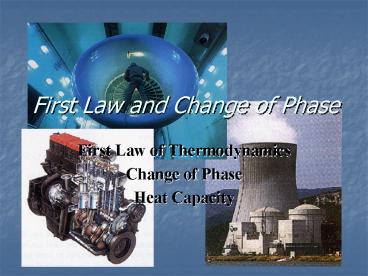First Law and Change of Phase - PowerPoint PPT Presentation
1 / 39
Title: First Law and Change of Phase
1
First Law and Change of Phase
- First Law of Thermodynamics
- Change of Phase
- Heat Capacity
2
Reading Questions
How many classes do we have left?
- 3
- 6
- 9
- 12
- 15
3
Reading Questions
What is the name of an ideal-gas process in which
no heat is transferred?
1. Isochoric 2. Isentropic 3. Isothermal 4.
Isobaric 5. Adiabatic
4
Reading Questions
What is the name of an ideal-gas process in which
no heat is transferred?
1. Isochoric 2. Isentropic 3. Isothermal 4.
Isobaric 5. Adiabatic
5
Reading Questions
What is the name of an ideal-gas process in which
no work is done?
1. Isochoric 2. Isentropic 3. Isothermal 4.
Isobaric 5. Adiabatic
6
Reading Questions
What is the name of an ideal-gas process in which
no work is done?
1. Isochoric 2. Isentropic 3. Isothermal 4.
Isobaric 5. Adiabatic
7
Reading Questions
Heat is
1. the amount of thermal energy in an object. 2.
the energy that moves from a hotter object to a
colder object. 3. a fluid-like substance that
flows from a hotter object to a colder object. 4.
Both 1 and 2. 5. Both 2 and 3.
8
Reading Questions
Heat is
1. the amount of thermal energy in an object. 2.
the energy that moves from a hotter object to a
colder object. 3. a fluid-like substance that
flows from a hotter object to a colder object. 4.
Both 1 and 2. 5. Both 2 and 3.
9
Reading Questions
The thermal behavior of water is characterized by
the value of its
1. heat density. 2. heat constant. 3. specific
heat. 4. thermal index.
10
Reading Questions
The thermal behavior of water is characterized by
the value of its
1. heat density. 2. heat constant. 3. specific
heat. 4. thermal index.
11
First Law of Thermodynamics
- First Law of Thermodynamics
The change in the thermal (internal) energy of a
system depends only on the net heat transfer to
the system and the net work done on the system,
and is independent of the particular processes
involved.
Heat
Heat added to the system is positive Work done on
the system is positive
Work
12
First Law of Thermodynamics
- First Law of Thermodynamics
Heat
Work
13
First Law of Thermodynamics
- Thermodynamic Work
14
First Law of Thermodynamics
- Isochoric Process (Constant Volume)
- Isobaric Process (Constant Pressure)
15
First Law of Thermodynamics
- Isothermal Process for an Ideal Gas
16
First Law of Thermodynamics
- First Law of Thermodynamics
17
First Law of Thermodynamics
- Thermodynamics Processes
18
First Law of Thermodynamics
- Thermodynamics Processes
work
19
First Law of Thermodynamics
- Thermodynamics Processes
20
Student Workbook
21
Student Workbook
22
Student Workbook
23
Student Workbook
24
Student Workbook
25
Class Questions
Two process are shown that take an ideal gas from
state 1 to state 3. Compare the work done by
process A to the work done by process B.
1. WA WB 0 2. WA gt WB 3. WA WB but
neither is zero 4. WA lt WB
26
Class Questions
Two process are shown that take an ideal gas from
state 1 to state 3. Compare the work done by
process A to the work done by process B.
1. WA WB 0 2. WA gt WB 3. WA WB but
neither is zero 4. WA lt WB
27
Class Questions
Which of the following processes involve heat?
1. The brakes in your car get hot when you
stop. 2. A steel block is placed under a
candle. 3. You push a rigid cylinder of gas
across a frictionless surface. 4. You push a
piston into a cylinder of gas, increasing the
temperature of the gas. 5. You place a cylinder
of gas in hot water. The gas expands, causing a
piston to rise and lift a weight. The temperature
of the gas does not change.
28
Class Questions
Which of the following processes involve heat?
1. The brakes in your car get hot when you
stop. 2. A steel block is placed under a
candle. 3. You push a rigid cylinder of gas
across a frictionless surface. 4. You push a
piston into a cylinder of gas, increasing the
temperature of the gas. 5. You place a cylinder
of gas in hot water. The gas expands, causing a
piston to rise and lift a weight. The temperature
of the gas does not change.
29
First Law of Thermodynamics
- Heat of Transformation
Slope a heat capacity
- Heat of fusion the heat to transform a gram of
substance from solid to liquid.
Qf or - mLf
- Heat of vaporization the heat to transform a
gram of substance from liquid to gas.
Q a time
Qv or - mLv
- Sublimation solid to gas
30
First Law of Thermodynamics
- Heat of Transformation
31
First Law of Thermodynamics
- Heat Capacity and Specific Heat
32
First Law of Thermodynamics
- Specific Heat
33
First Law of Thermodynamics
- Specific Heat for an Ideal Gas
34
First Law of Thermodynamics
- Adiabatic Processes
35
First Law of Thermodynamics
36
First Law of Thermodynamics
- Work and Calorimetry
37
Student Workbook
38
First Law of Thermodynamics
- Heat Capacity
Rotational modes
Vibrational modes
39
First Law of Thermodynamics
- Heat Capacity
Translational modes
Equipartition of Energy When a system is in
thermodynamic equilibrium, the average energy per
molecule is ½ kT per degree of freedom.
Rotational modes
Vibrational modes































